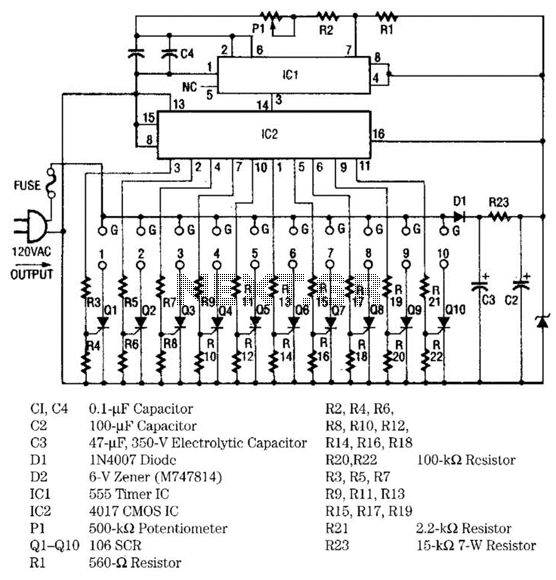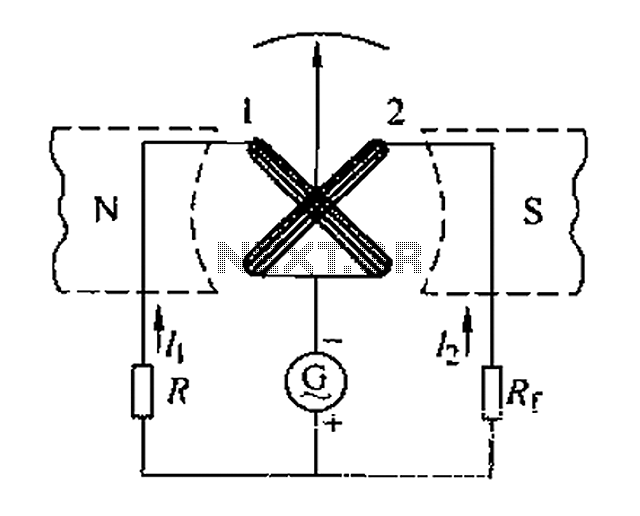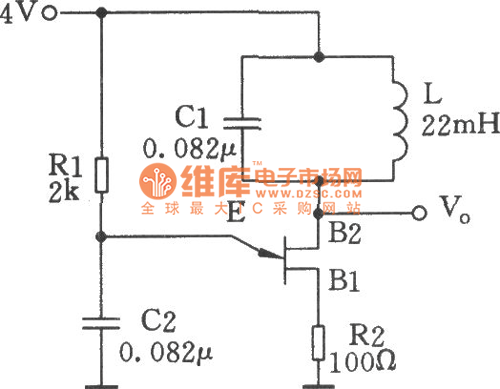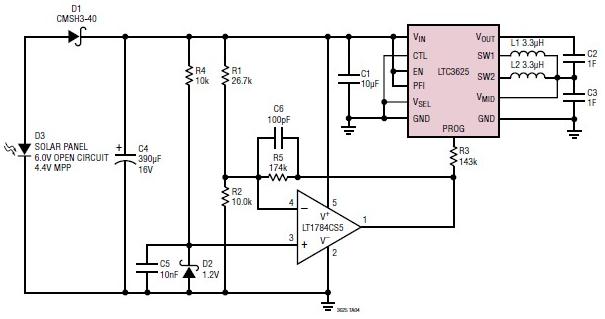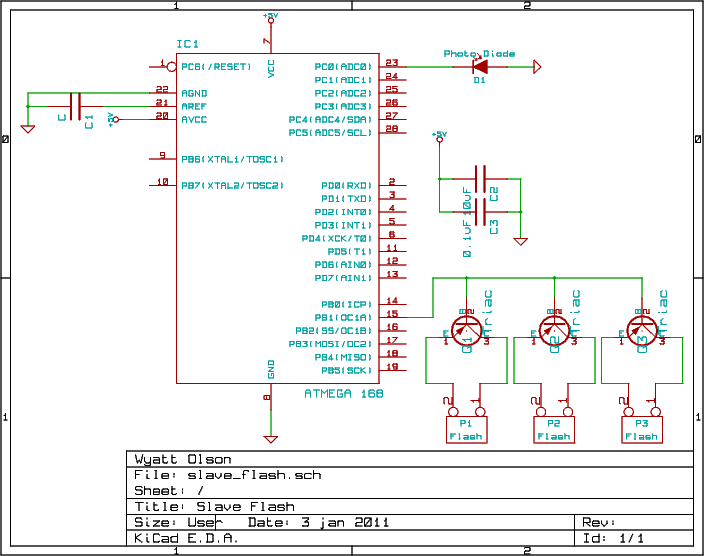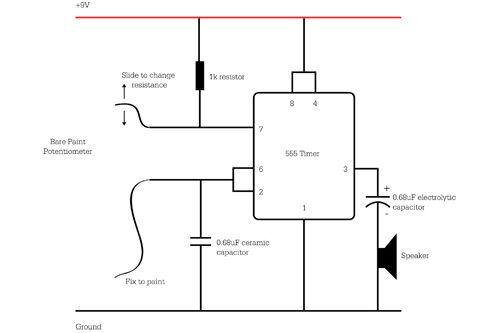
Trigger Circuit Controls Stop-Motion Camera System
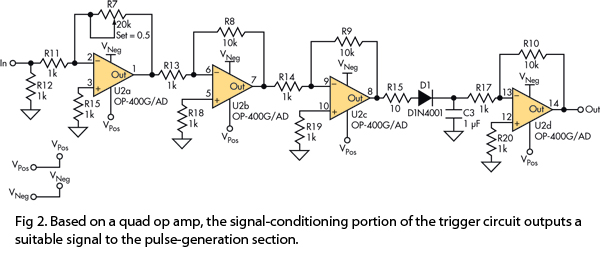
This version of the trigger circuit for the stop-motion camera system utilizes an electret microphone for sonic input, although it can be replaced with an LED and photodiode pair for optical triggering. A recent home-built project involved constructing a stop-motion camera system that incorporated a timed flash and shutter mechanism. The system necessitated a trigger mechanism to initiate timing. The required input trigger for the system controller is a pulse train consisting of at least two pulses. Once the system is armed, the first incoming pulse serves as a pre-trigger, while the second pulse acts as the final trigger. The circuit is designed to accommodate either an optical trigger (light curtain) or a sonic trigger, and minor modifications allow for compatibility with both. All components are through-hole types, selected for their availability. The trigger circuit consists of five primary components: the sensor, the conditioner, the pulse generator, the opto-isolator, and the power conditioner. The power conditioner, which is not detailed here, provides both positive and negative 9 V to the circuitry on the board, utilizing an LM317 and an LM337 for regulation. The use of an opto-isolated output in the trigger circuit is essential for several reasons. Firstly, to prevent ground loops that could lead to random activations of the system controller, which had been observed during previous tests. Secondly, the voltage levels of ±9 V used on this board are incompatible with the +5 V circuitry of the system controller. Lastly, the flash circuit on a separate board could potentially generate a significant ground bounce (a 10-µs discharge of approximately 1200 V), risking damage to other components. It is important to note that the opto-isolator base connection (pin 6) is left floating. The trigger input is provided by an electret microphone, featuring a four-terminal connector with two resistive +9-V pins and two returns; however, only two of these pins are utilized. Alternatively, an LED and photodiode pair can be used in place of the electret microphone. In this configuration, one device connects to one pair of power/return pins, while the other device connects to the other pair. In both scenarios, the sensor hot is connected to the resistive power output returning through a 22-µF capacitor, which blocks DC and allows only the pulse from the photodiode or noise from the electret to pass to the signal-conditioning circuit. The signal conditioner employs an OP-400 operational amplifier, although any modern quad op-amp could suffice. Resistor R12 serves primarily as a load and impedance matching device for the sensor. U2a is configured to provide a variable voltage gain ranging from zero to approximately 20. U2b and U2c amplify the output of U2a by a factor of around 100. After assembly, R7 can be adjusted to achieve the desired output at U2d, with different gain levels required for the optical and electret circuits. The combination of R16, D1, and C3 forms a pulse-shaping network that ensures the output from U2d is a pulse or series of pulses. U2d provides a slight gain to the pulse and inverts its polarity to align with the next stage of the system. This negative pulse is then transmitted through C5 to the pulse-generation circuit, with C5 blocking the DC voltage VPos (+9 V) from U2d's output. Resistor R14 acts as a pull-up to guarantee the correct input to the pulse-generation circuit. When functioning correctly, the input to the pulse-generation circuit is an active-low trigger. R17 has been left unpopulated, as its necessity in the hardware was uncertain during the design phase, thus allowing for future installation if required. The pulse-generation circuit comprises two 555 timer ICs configured in series. The first timer (U5) is set up as a monostable multivibrator, generating a single positive pulse at pin 3 upon receiving an input trigger. The duration of this pulse can be adjusted by modifying R27.This version of the trigger circuit for the stop-motion camera system uses an electret microphone for a sonic input, but the designer can substitute an LED and photodiode pair to create an optical trigger. For a recent home-brew project, I built a stop-motion camera system using a timed flash and shutter system.
The system required a trigge r mechanism to set the timing in motion. The input trigger needed by the system controller is a pulse train of at least two pulses. After the system is armed, the first incoming pulse acts as a pre-trigger, and the second is the final trigger for the system. The circuit can use either an optical trigger (a light curtain ) or a sonic trigger. With very minor modifications, it can work with both triggers. The parts are all through-hole components, chosen for availability. The trigger circuit comprises five major components: the sensor, the conditioner, the pulse generator, the opto-isolator, and the power conditioner ( Fig.
1 ). The power conditioner, which is not discussed in this article, supplies both positive and negative 9 V to all the circuitry on the board, using an LM317 and an LM337, respectively. For several reasons, the trigger circuit uses an opto-isolated output. First, due to the sensitivities of the controller, I had to ensure that no ground loops were present.
Previous tinkering had shown that they could cause random firing of the system controller. Second, the voltage levels ( ±9 V) used on this board aren`t compatible with the system controller circuitry (+5 V). Finally, the flash circuit (on another board) could potentially cause a large ground bounce (a 10- µs discharge of about 1200 V) that could damage circuitry elsewhere.
Note that the opto-isolator base connection (pin 6) is left floating. The trigger input is an electret microphone. The microphone has a four-terminal connector, two resistive +9-V pins, and two returns, but only two of these pins are used. You can substitute an LED and photodiode pair for the electrets. If so, one of the devices uses one pair of power/return pins, and the other device uses the other pair.
In both cases, the sensor hot is tied to the resistive power output that comes back through the 22- µF capacitor. The capacitor blocks dc, allowing only the pulse from the photodiode or noise from the electret through to the signal-conditioning circuit.
The signal-conditioner circuit employs an OP-400, just because I had several on hand ( Fig. 2 ). Any modern quad op-amp could be used. R12 is used primarily as a load/impedance matching device for the sensor. U2a is configured to deliver a variable voltage gain of from zero to about 20. U2b and U2c provide a gain of approximately 100 for U2a`s output. Once the circuit is built, you can adjust R7 to get the appropriate output at U2d. Obviously, differing amounts of gain were required for the optical and electret circuits. R16, D1, and C3 form a pulse-shaping network that ensures that the output of U2d is a pulse or series of pulses. Finally, U2d provides a small amount of gain to the pulse and reverses its polarity to match the next stage of the system.
This negative-going pulse is sent through C5 ( Fig. 1, again ) to the pulse-generation circuit. C5 blocks the dc voltage VPos (+9 V) from the output of U2d. R14 is a pull-up resistor that ensures the input to the pulse-generation circuit is correct. When all is working correctly, the input to the pulse-generation circuit is an active-low trigger. R17 was left unpopulated. It was originally unknown if it would be needed in real hardware, so the ability to install it was left in the printed-circuit board (PCB). The pulse-generation circuit is simply two 555 timer devices, one fed into the other ( Fig. 3 ). The first (U5) is set up as a one shot. That is, an input trigger causes a single positive pulse to come out of pin 3. The length of this pulse can be adjusted by changing R27 🔗 External reference
The system required a trigge r mechanism to set the timing in motion. The input trigger needed by the system controller is a pulse train of at least two pulses. After the system is armed, the first incoming pulse acts as a pre-trigger, and the second is the final trigger for the system. The circuit can use either an optical trigger (a light curtain ) or a sonic trigger. With very minor modifications, it can work with both triggers. The parts are all through-hole components, chosen for availability. The trigger circuit comprises five major components: the sensor, the conditioner, the pulse generator, the opto-isolator, and the power conditioner ( Fig.
1 ). The power conditioner, which is not discussed in this article, supplies both positive and negative 9 V to all the circuitry on the board, using an LM317 and an LM337, respectively. For several reasons, the trigger circuit uses an opto-isolated output. First, due to the sensitivities of the controller, I had to ensure that no ground loops were present.
Previous tinkering had shown that they could cause random firing of the system controller. Second, the voltage levels ( ±9 V) used on this board aren`t compatible with the system controller circuitry (+5 V). Finally, the flash circuit (on another board) could potentially cause a large ground bounce (a 10- µs discharge of about 1200 V) that could damage circuitry elsewhere.
Note that the opto-isolator base connection (pin 6) is left floating. The trigger input is an electret microphone. The microphone has a four-terminal connector, two resistive +9-V pins, and two returns, but only two of these pins are used. You can substitute an LED and photodiode pair for the electrets. If so, one of the devices uses one pair of power/return pins, and the other device uses the other pair.
In both cases, the sensor hot is tied to the resistive power output that comes back through the 22- µF capacitor. The capacitor blocks dc, allowing only the pulse from the photodiode or noise from the electret through to the signal-conditioning circuit.
The signal-conditioner circuit employs an OP-400, just because I had several on hand ( Fig. 2 ). Any modern quad op-amp could be used. R12 is used primarily as a load/impedance matching device for the sensor. U2a is configured to deliver a variable voltage gain of from zero to about 20. U2b and U2c provide a gain of approximately 100 for U2a`s output. Once the circuit is built, you can adjust R7 to get the appropriate output at U2d. Obviously, differing amounts of gain were required for the optical and electret circuits. R16, D1, and C3 form a pulse-shaping network that ensures that the output of U2d is a pulse or series of pulses. Finally, U2d provides a small amount of gain to the pulse and reverses its polarity to match the next stage of the system.
This negative-going pulse is sent through C5 ( Fig. 1, again ) to the pulse-generation circuit. C5 blocks the dc voltage VPos (+9 V) from the output of U2d. R14 is a pull-up resistor that ensures the input to the pulse-generation circuit is correct. When all is working correctly, the input to the pulse-generation circuit is an active-low trigger. R17 was left unpopulated. It was originally unknown if it would be needed in real hardware, so the ability to install it was left in the printed-circuit board (PCB). The pulse-generation circuit is simply two 555 timer devices, one fed into the other ( Fig. 3 ). The first (U5) is set up as a one shot. That is, an input trigger causes a single positive pulse to come out of pin 3. The length of this pulse can be adjusted by changing R27 🔗 External reference
